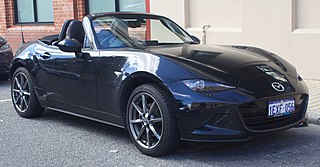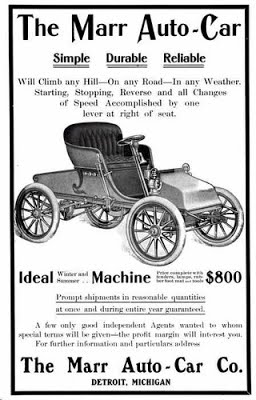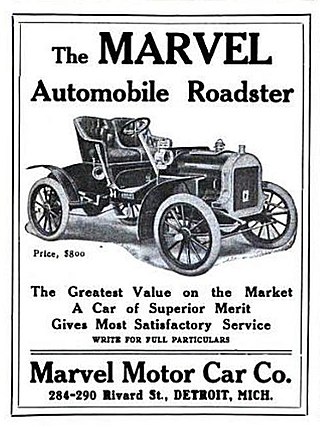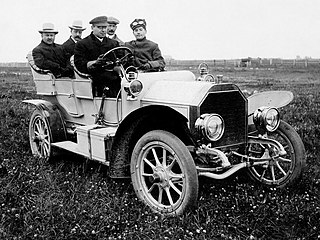Related Research Articles

The Ford Model T is an automobile that was produced by the Ford Motor Company from October 1, 1908, to May 26, 1927. It is generally regarded as the first mass-affordable automobile, which made car travel available to middle-class Americans. The relatively low price was partly the result of Ford's efficient fabrication, including assembly line production instead of individual handcrafting. The savings from mass production allowed the price to decline from $780 in 1910 to $290 in 1924. It was mainly designed by three engineers, Joseph A. Galamb, Eugene Farkas, and Childe Harold Wills. The Model T was colloquially known as the "Tin Lizzie".

The Fiat X1/9 is an Italian two-seater mid-engined sports car designed by Bertone and manufactured by Fiat from 1972–1982 and subsequently by Gruppo Bertone from 1982–1989.

Zeta is a marque of automobile which was produced in Australia from 1963 to 1965 by South Australian manufacturing company Lightburn & Co.

A roadster is an open two-seat car with emphasis on sporting appearance or character. Initially an American term for a two-seat car with no weather protection, its usage has spread internationally and has evolved to include two-seat convertibles.

Touring car and tourer are both terms for open cars. "Touring car" is a style of open car built in the United States which seats four or more people. The style was popular from the early 1900s to the 1930s. The cars used for touring car racing in various series since the 1960s, are unrelated to these early touring cars, despite sharing the same name.

The gasoline-powered Oldsmobile Model R, also known as the Curved Dash Oldsmobile, is credited as being the first mass-produced automobile, meaning that it was built on an assembly line using interchangeable parts. It was introduced by the Oldsmobile company in 1901 and produced through 1903; 425 were produced the first year, 2,500 in 1902, and over 19,000 were built in all. When General Motors assumed operations from Ransom E. Olds on November 12, 1908, GM introduced the Oldsmobile Model 20, which was the 1908 Buick Model 10 with a stretched wheelbase and minor exterior changes.

The Ford Model C is an automobile that was produced by Ford Motor Company. Introduced in late 1904, the Model C was Ford's lower priced 1905 model. The first sales were in October 1904, with most sold during the 1905 calendar year. Horace Dodge made major changes to the design of the engine, rear axle and other parts of the car. The Model C used the same 10 hp motor the 1904 Model A was equipped with. Model C had a longer wheelbase than the earlier Model A. Built at the Ford Piquette Avenue Plant, it was the entry-level car in the Ford model lineup, slotting below the upscale Model B. Production ended in 1905 with approximately 1,000 cars produced. About 160-170 Model C were assembled in Canada at Ford's new Ford Canada location in Walkerville. Due to the Dodge Brothers owning a ten percent share of the company, as well as supplying many parts and assemblies, the Model C took to the road with Dodge-built engines and other key assemblies.

The Ford Model N is an automobile produced by Ford Motor Company; it was introduced in 1906 as a successor to the Models A and C as the company's inexpensive, entry-level line. It was built at the Ford Piquette Avenue Plant.

A runabout is a car body style popular in the 1910s, based on the horse-drawn runabout carriage.

The Knox Automobile Company was a manufacturer of automobiles in Springfield, Massachusetts, United States, between 1900 and 1914. Knox also built trucks and farm tractors until 1924. They are notable for building the very first modern fire engine in 1905, and the first American vehicle with hydraulic brakes, in 1915.

St. Louis Motor Carriage Company was a manufacturer of automobiles at 1211–13 North Vandeventer Avenue in St. Louis, Missouri, founded by George Preston Dorris and John L. French in 1898, with French taking charge of marketing and Dorris heading engineering and production. St. Louis Motor Carriage was the first of many St. Louis automakers and produced automobiles from 1899 to 1907.

Templar was a manufacturer of automobiles in Lakewood, Ohio from 1917 to 1924. The company was named for the Knights Templar and used a Maltese Cross as an emblem.

The first Cadillac automobiles were the 1903 Model built in the last quarter of 1902. These were 2-seater "horseless carriages" powered by a reliable and sturdy 10 hp (7 kW) single-cylinder engine developed by Alanson Partridge Brush and built by Leland and Faulconer Manufacturing Company of Detroit, of which Henry Leland was founder, vice-president and general manager.
Columbia was an American brand of automobiles produced by a group of companies in the United States. They included the Pope Manufacturing Company of Hartford, Connecticut, the Electric Vehicle Company, and an entity of brief existence in 1899, the Columbia Automobile Company.

The Empire was an American automobile manufactured from 1910 until 1919. Marketed as "the little aristocrat", the Empire 20 was a four-cylinder shaft-driven runabout built in Indianapolis. The model "A" was a conventional runabout for three passengers with a rumble seat. The model "B" had two bucket seats, a longer hood and was geared higher to attain faster speeds.

The Union automobile was a vehicle manufactured by the Union Automobile Company from 1902 until 1905. It was designed by John William Lambert, who had developed the three-wheel Buckeye gasoline buggy in 1891. Over the next decade, Lambert substantially refined the vehicle, with modifications including an additional wheel, a more powerful engine, and a new transmission system. The Union Automobile Company was formed as a subsidiary of Lambert's Buckeye Manufacturing Company solely to manufacture the Union, which took its name from Union City, Indiana, the city where it was built and which endorsed its production. In total, the company built over three hundred Union automobiles, before development shifted to the Lambert automobile, the Union's successor.

The Marr Auto-Car was an automobile built in Elgin, Illinois by the Marr Auto-Car Company from 1902 to 1904.

The Marvel was an automobile built at 284–290 Rivard Street, Detroit, Michigan, United States, by the Marvel Motor Car Company in 1907.

The Cunningham Car Company was a pioneering American production automobile manufacturer. Theirs was one of the earliest vehicles of the automotive age. Cunninghams were produced from 1896 to 1931 in Rochester, New York by James Cunningham, Son and Company who had been in the carriage manufacturing business since 1836.

The Model S was the first four-seat passenger car produced by Oldsmobile in 1906, offered as a larger alternative to the Model R Curved Dash runabout that appeared in 1901. The advertised price was $2,250. It was Oldsmobile's first four cylinder car and took the top level marketing position above the Model L and the entry-level Model R. It was one of the last independently developed products before they joined General Motors in 1908, and competed against Buick, Ford and other automakers at the time. It was built at the Oldsmobile factory in Detroit and developed by Frederick and Angus Smith, whose father Samuel L. Smith was the primary investor, and R. E. Olds had left the company due to an argument with Oldsmobile Board of Directors.
References
- 1 2 Kimes, Beverly Rae; Clark Jr., Henry Austin (1996). Standard Catalog of American Cars 1805-1942 (3rd ed.). Krause Publications. ISBN 978-0-87341-428-9.